Optimizing the Landing Stability of Blended-Wing-Body Aircraft with Distributed Electric Boundary-Layer Ingestion Propulsors through a Novel Thrust Control Configuration
Abstract
1. Introduction
2. Overcoming Sagging and Altitude Loss Problems: Effective Solutions
2.1. Sagging and Altitude Loss Problems of BWB Aircraft
2.2. Effective Thrust Control Configuration for BWB Aircraft
2.2.1. A Dual-Layer Sleeve Thrust Control Configuration
2.2.2. A Separate Flap-Type Thrust Control Configuration
2.2.3. A Single-Stage Linkage Flap-Type Thrust Control Configuration
2.2.4. A Dual-Stage Linkage Flap-Type Thrust Control Configuration
2.2.5. Summary of Thrust Control Configuration
3. Analytical Model and Experimental Setup
3.1. Analytical Model
3.2. Experimental Setup
4. Results and Discussion
4.1. Symmetrical Deflection of Both Cascades
4.2. Deflection of the Upper Cascades
4.3. Deflection of the Lower Cascades
4.4. Deflection Angle Combinations for Zero Pitch Moment
4.5. Comparison of Landing Stability Optimization Methods
5. Conclusions
- (1)
- The novel thrust control configuration can effectively adjust the thrust to 0 without adjusting the BLI fan speed of the propulsion system, improving the landing stability of BWB aircraft and solving the tightly coupled problem between lift and thrust caused by BLI fans sucking in the boundary layer. The challenge in using flaps and engine thrust reversers to decelerate electric BWB aircraft can be overcome.
- (2)
- The symmetrical deflection of both cascades of the thrust control configuration can increase lift and provide an upward moment. This indicates that the deflection of the thrust control configuration significantly changes the flow field state and can be adjusted to achieve the goal of augmenting lift and reducing drag in landing and approach use scenarios. The additional upward moment provided meets the requirements for larger attitude angles, which can replace the upward movement of elevators and improve aerodynamic efficiency.
- (3)
- The asymmetric deflection scheme can achieve a zero additional pitch moment with specific deflection angle combinations and effectively adjust the thrust to 20% while maintaining the original additional lift effects and producing some additional lift benefits. This method also achieves the objectives of augmenting lift and reducing drag without inducing additional changes in the pitch moment.
Author Contributions
Funding
Institutional Review Board Statement
Informed Consent Statement
Data Availability Statement
Conflicts of Interest
References
- Moirou, N.G.M.; Sanders, D.S.; Laskaridis, P. Advancements and Prospects of Boundary Layer Ingestion Propulsion Concepts. Prog. Aerosp. Sci. 2023, 138, 100897. [Google Scholar] [CrossRef]
- Bravo-Mosquera, P.D.; Catalano, F.M.; Zingg, D.W. Unconventional Aircraft for Civil Aviation: A Review of Concepts and Design Methodologies. Prog. Aerosp. Sci. 2022, 131, 100813. [Google Scholar] [CrossRef]
- Fard, M.T.; He, J.; Huang, H.; Cao, Y. Aircraft Distributed Electric Propulsion Technologies—A Review. IEEE Trans. Transp. Electrific. 2022, 8, 4067–4090. [Google Scholar] [CrossRef]
- Chaudhary, S.; Sharma, D. A comprehensive review on blended wing body aircraft. Vidyabharati Int. Interdiscip. Res. J. 2021, 12, 271–278. [Google Scholar]
- Sahoo, S.; Zhao, X.; Kyprianidis, K. A Review of Concepts, Benefits, and Challenges for Future Electrical Propulsion-Based Aircraft. Aerospace 2020, 7, 44. [Google Scholar] [CrossRef]
- Rendón, M.A.; Sánchez, R.C.D.; Gallo, M.J.; Anzai, A.H. Aircraft Hybrid-Electric Propulsion: Development Trends, Challenges and Opportunities. J. Control Autom. Electr. Syst. 2021, 32, 1244–1268. [Google Scholar] [CrossRef]
- Handa, S.; Srinivas, G. Recent Developments of Blended Wing Body Aircraft: Experimental, Numerical and Theoretical Approaches. Aerosp. Syst. 2022, 5, 171–183. [Google Scholar] [CrossRef]
- Felder, J.L.; Tong, M.T.; Schnulo, S.L.; Berton, J.J.; Thacker, R.P.; Haller, W.J.; Kirk, J.; Guynn, M.D. Updated Assessment of Turboelectric Boundary Layer Ingestion Propulsion Applied to Single-Aisle Commercial Transport; Glenn Research Center: Cleveland, OH, USA, 2022. [Google Scholar]
- Okonkwo, P.; Smith, H. Review of Evolving Trends in Blended Wing Body Aircraft Design. Prog. Aerosp. Sci. 2016, 82, 1–23. [Google Scholar] [CrossRef]
- Kim, H.D.; Perry, A.T.; Ansell, P.J. A Review of Distributed Electric Propulsion Concepts for Air Vehicle Technology. In Proceedings of the 2018 AIAA/IEEE Electric Aircraft Technologies Symposium, Cincinnati, OH, USA, 9–11 July 2018; American Institute of Aeronautics and Astronautics: Reston, VA, USA, 2018. [Google Scholar]
- Gohardani, A.S.; Doulgeris, G.; Singh, R. Challenges of Future Aircraft Propulsion: A Review of Distributed Propulsion Technology and Its Potential Application for the All Electric Commercial Aircraft. Prog. Aerosp. Sci. 2011, 47, 369–391. [Google Scholar] [CrossRef]
- Brown, M.; Vos, R. Conceptual Design and Evaluation of Blended-Wing Body Aircraft. In Proceedings of the 2018 AIAA Aerospace Sciences Meeting, Kissimmee, FL, USA, 8–12 January 2018; American Institute of Aeronautics and Astronautics: Reston, VA, USA, 2018. [Google Scholar]
- Niu, X.; Li, J.; Zhang, H.; Yang, Z. Investigation of Improvement Design on Aileron Surface Flow State of High Lift Configuration in BWB. Aerospace 2022, 9, 842. [Google Scholar] [CrossRef]
- Ammar, S.; Legros, C.; Trépanier, J.-Y. Conceptual Design, Performance and Stability Analysis of a 200 Passengers Blended Wing Body Aircraft. Aerosp. Sci. Technol. 2017, 71, 325–336. [Google Scholar] [CrossRef]
- Yu, G.; Duan, Y. Design Improvement of a BWB Aerodynamic Performance at Cruise and Take-Off Speeds. Int. J. Aerosp. Eng. 2022, 2022, 5216387. [Google Scholar] [CrossRef]
- Kleemann, N.; Karpuk, S.; Elham, A. Conceptual Design and Optimization of a Solar-Electric Blended Wing Body Aircraft for General Aviation. In Proceedings of the AIAA Scitech 2020 Forum, Orlando, FL, USA, 6–10 January 2020; American Institute of Aeronautics and Astronautics: Reston, VA, USA, 2020. [Google Scholar]
- Wang, K.; Zhou, Z. Aerodynamic Design, Analysis and Validation of a Small Blended-Wing-Body Unmanned Aerial Vehicle. Aerospace 2022, 9, 36. [Google Scholar] [CrossRef]
- Mv, M.; Mondal, P.; Karn, P.K.; Kumar, P. Aerodynamic Investigation of Blended Wing Body Configuration. Def. Sci. J. 2023, 73, 283–292. [Google Scholar] [CrossRef]
- Hossan, S.; Srinivas, G. Aerodynamic Performance Improvement of a Blended Wing-Body Re-Entry Vehicle Using ANSYS CFX. Aerosp. Syst. 2023, 7, 29–42. [Google Scholar] [CrossRef]
- Agarwal, D.; Marques, S.; Robinson, T.T. Aerodynamic Shape Optimisation Using Parametric CAD and Discrete Adjoint. Aerospace 2022, 9, 743. [Google Scholar] [CrossRef]
- Kerho, M.F. Aero-Propulsive Coupling of an Embedded, Distributed Propulsion System. In Proceedings of the 33rd AIAA Applied Aerodynamics Conference, Dallas, TX, USA, 22–26 June 2015; American Institute of Aeronautics and Astronautics: Reston, VA, USA, 2015. [Google Scholar]
- Urban, D.; Kusmirek, S.; Socha, V.; Hanakova, L.; Hylmar, K.; Kraus, J. Effect of Electric Ducted Fans Structural Arrangement on Their Performance Characteristics. Appl. Sci. 2023, 13, 2787. [Google Scholar] [CrossRef]
- Zhao, W.; Zhang, Y.; Wu, J. Energy-Based Aerodynamic Analysis on the Blended-Wing-Body Aircraft with Boundary Layer Ingestion. Int. J. Aerosp. Eng. 2022, 2022, 6452099. [Google Scholar] [CrossRef]
- Giuliani, J.E.; Chen, J.P.; Beach, T.A.; Bakhle, M.A. Numerical Simulation of Boundary Layer Ingesting (BLI) Inlet/Fan Interaction. In Proceedings of the 50th AIAA/ASME/SAE/ASEE Joint Propulsion Conference, Cleveland, OH, USA, 28–30 July 2014; American Institute of Aeronautics and Astronautics: Reston, VA, USA, 2014. [Google Scholar]
- Jia, Y.; Li, J.; Wu, J. Power Fan Design of Blended-Wing-Body Aircraft with Distributed Propulsion System. Int. J. Aerosp. Eng. 2021, 2021, 5128136. [Google Scholar] [CrossRef]
- Seitz, A.; Habermann, A.L.; Peter, F.; Troeltsch, F.; Castillo Pardo, A.; Della Corte, B.; Van Sluis, M.; Goraj, Z.; Kowalski, M.; Zhao, X.; et al. Proof of Concept Study for Fuselage Boundary Layer Ingesting Propulsion. Aerospace 2021, 8, 16. [Google Scholar] [CrossRef]
- Diamantidou, D.E.; Hosain, M.L.; Kyprianidis, K.G. Recent Advances in Boundary Layer Ingestion Technology of Evolving Powertrain Systems. Sustainability 2022, 14, 1731. [Google Scholar] [CrossRef]
- Yu, G.; Li, D.; Zhang, Z. Numerical Simulation for the Differences between FTN/WPN Engine Models Aerodynamic Influence on BWB300 Airframe. Eng. Appl. Comput. Fluid Mech. 2020, 14, 566–579. [Google Scholar] [CrossRef]
- Wu, J.; Gao, F.; Li, S.; Yang, F. Conceptual Design and Optimization of Distributed Electric Propulsion General Aviation Aircraft. Aerospace 2023, 10, 387. [Google Scholar] [CrossRef]
- Hospodář, P.; Klesa, J.; Žižkovský, N. Design of Distributed Propulsion System for General Aviation Airplane. MATEC Web Conf. 2019, 304, 03009. [Google Scholar] [CrossRef]
- Burston, M.; Ranasinghe, K.; Gardi, A.; Parezanović, V.; Ajaj, R.; Sabatini, R. Design Principles and Digital Control of Advanced Distributed Propulsion Systems. Energy 2022, 241, 122788. [Google Scholar] [CrossRef]
- Zhang, X.; Zhang, W.; Li, W.; Zhang, X.; Lei, T. Experimental Research on Aero-Propulsion Coupling Characteristics of a Distributed Electric Propulsion Aircraft. Chin. J. Aeronaut. 2023, 36, 201–212. [Google Scholar] [CrossRef]
- Wick, A.T.; Hooker, J.R.; Zeune, C.H. Integrated Aerodynamic Benefits of Distributed Propulsion. In Proceedings of the 53rd AIAA Aerospace Sciences Meeting, Kissimmee, FL, USA, 5–9 January 2015; American Institute of Aeronautics and Astronautics: Reston, VA, USA, 2015. [Google Scholar]
- Zhao, W.; Zhang, Y.; Tang, P.; Wu, J. The Impact of Distributed Propulsion on the Aerodynamic Characteristics of a Blended-Wing-Body Aircraft. Aerospace 2022, 9, 704. [Google Scholar] [CrossRef]
- Reist, T.A.; Zingg, D.W.; Rakowitz, M.; Potter, G.; Banerjee, S. Multifidelity Optimization of Hybrid Wing–Body Aircraft with Stability and Control Requirements. J. Aircr. 2019, 56, 442–456. [Google Scholar] [CrossRef]
- Chang, M.; Zheng, Z.; Meng, X.; Bai, J.; Wang, B. Aerodynamic Analysis of a Low-Speed Tandem-Channel Wing for eVTOL Aircraft Considering Propeller–Wing Interaction. Energies 2022, 15, 8616. [Google Scholar] [CrossRef]
- Vechtel, D.; Buch, J.-P. Aspects of Yaw Control Design of an Aircraft with Distributed Electric Propulsion. CEAS Aeronaut. J. 2022, 13, 847–860. [Google Scholar] [CrossRef]
- Chen, Z.; Zhang, M.; Chen, Y.; Sang, W.; Tan, Z.; Li, D.; Zhang, B. Assessment on Critical Technologies for Conceptual Design of Blended-Wing-Body Civil Aircraft. Chin. J. Aeronaut. 2019, 32, 1797–1827. [Google Scholar] [CrossRef]
- Paulus, D.; Wirth, C.; Hornung, M. Blended Wing Body Aircraft—Recommendations from High Lift and Control Surface Design and Optimization. In Proceedings of the 31st AIAA Applied Aerodynamics Conference, San Diego, CA, USA, 24–27 June 2013; American Institute of Aeronautics and Astronautics: Reston, VA, USA, 2013. [Google Scholar]
- Sargeant, M.A.; Hynes, T.P.; Graham, W.R.; Hileman, J.I.; Drela, M.; Spakovszky, Z.S. Stability of Hybrid-Wing-Body-Type Aircraft with Centerbody Leading-Edge Carving. J. Aircr. 2010, 47, 970–974. [Google Scholar] [CrossRef]
- Lou, Y.; Chen, Z.; Jiang, S. Numerical Simulation on Influence of Thrust Reverser Device on Aerodynamic Performance of Blended-Wing-Body Distributed Propulsion System. J. Aerosp. Power 2019, 34, 2211–2217. [Google Scholar]
- Ye, Z.; Chen, Y.; Cai, P.; Lyu, H.; Gong, Z.; Wu, J. Control Design for Soft Transition for Landing Preparation of Light Compound-Wing Unmanned Aerial Vehicles Based on Incremental Nonlinear Dynamic Inversion. Appl. Sci. 2023, 13, 12225. [Google Scholar] [CrossRef]
- Lu, Y.; Zhang, S.; Li, X. A Hazard Analysis-Based Approach to Improve the Landing Safety of a BWB Remotely Piloted Vehicle. Chin. J. Aeronaut. 2012, 25, 846–853. [Google Scholar] [CrossRef]
- Staelens, Y.; Blackwelder, R.; Page, M. Study of Belly-Flaps to Enhance Lift- and Pitching Moment Coefficient of a BWB-Airplane. In Proceedings of the 25th AIAA Applied Aerodynamics Conference, Miami, FL, USA, 25–28 June 2007; American Institute of Aeronautics and Astronautics: Reston, VA, USA, 2007. [Google Scholar]
- Xin, Z.; Chen, Z.; Gu, W.; Zhang, M.; Zhang, B. Externally Blown Elevon Applied for the Longitudinal Control of Blended Wing Body Transport with Podded Engines. Aerosp. Sci. Technol. 2019, 93, 105324. [Google Scholar] [CrossRef]
- Viviani, A.; Aprovitola, A.; Iuspa, L.; Pezzella, G. Low Speed Longitudinal Aerodynamics of a Blended Wing-Body Re-Entry Vehicle. Aerosp. Sci. Technol. 2020, 107, 106303. [Google Scholar] [CrossRef]
- Chung, J.; Hallberg, E.; Cox, S.; Plyler, M. Landing Pitch Control Analysis of a Blended Wing Body UCAV. In Proceedings of the 48th AIAA Aerospace Sciences Meeting Including the New Horizons Forum and Aerospace Exposition, Orlando, FL, USA, 4–7 January 2010; American Institute of Aeronautics and Astronautics: Reston, VA, USA, 2010. [Google Scholar]
- Zhou, S.; Zhou, Y.; Xu, Z.; Chang, W.; Cheng, Y. The Landing Safety Prediction Model by Integrating Pattern Recognition and Markov Chain with Flight Data. Neural Comput. Appl. 2019, 31, 147–159. [Google Scholar] [CrossRef]
- Gang, Y.; Dong, L.; Zhenli, C.; Zeyu, Z. Blended Wing Body Thrust Reverser Cascade Feasibility Evaluation Through CFD. IEEE Access 2019, 7, 155184–155193. [Google Scholar] [CrossRef]
- Zhao, J.; Wang, X.; Meng, C.; Song, H.; Luo, Z.; Han, Q. Dynamic Modeling and Analysis of Thrust Reverser Mechanism Considering Clearance Joints and Flexible Component. Aerospace 2022, 9, 611. [Google Scholar] [CrossRef]
- Staelens, Y.; Blackwelder, R.; Page, M. Novel Pitch Control Effectors for a Blended Wing Body Airplane in Takeoff and Landing Configuration. In Proceedings of the 45th AIAA Aerospace Sciences Meeting and Exhibit, Reno, NV, USA, 8–11 January 2007; American Institute of Aeronautics and Astronautics: Reston, VA, USA, 2007. [Google Scholar]
- Anderson, J.D. Fundamentals of Aerodynamics, 6th ed.; McGraw-Hill Education: New York, NY, USA, 2017. [Google Scholar]
- Feng, Y.; Tang, J.; He, Z.; Xue, X.; Dong, M. Design of flap/spoiler follower mechanism for civil aircraft. J. Phys. Conf. Ser. 2023, 2472, 012016. [Google Scholar] [CrossRef]
- Tsirkunov, Y.M.; Lobanova, M.A.; Tsvetkov, A.I.; Schepanyuk, B.A. Effect of the wing trailing-edge flaps and spoilers position on the jet-vortex wake behind an aircraft during takeoff and landing run. In Proceedings of the 7th European Conference for Aeronautics and Space Sciences (EUCASS), Milan, Italy, 3–6 July 2017. [Google Scholar] [CrossRef]
- Hileman, J.; Spakovszky, Z.; Drela, M.; Sargeant, M.; Jones, A. Airframe design for silent fuel-efficient aircraft. J. Aircr. 2010, 47, 956–969. [Google Scholar] [CrossRef]
- Wildschek, A. Flight dynamics and control related challenges for design of a commercial blended wing body aircraft. In Proceedings of the AIAA Guidance, Navigation, and Control Conference, National Harbor, MD, USA, 13–17 January 2014; AIAA: Reston, VA, USA, 2014. [Google Scholar]

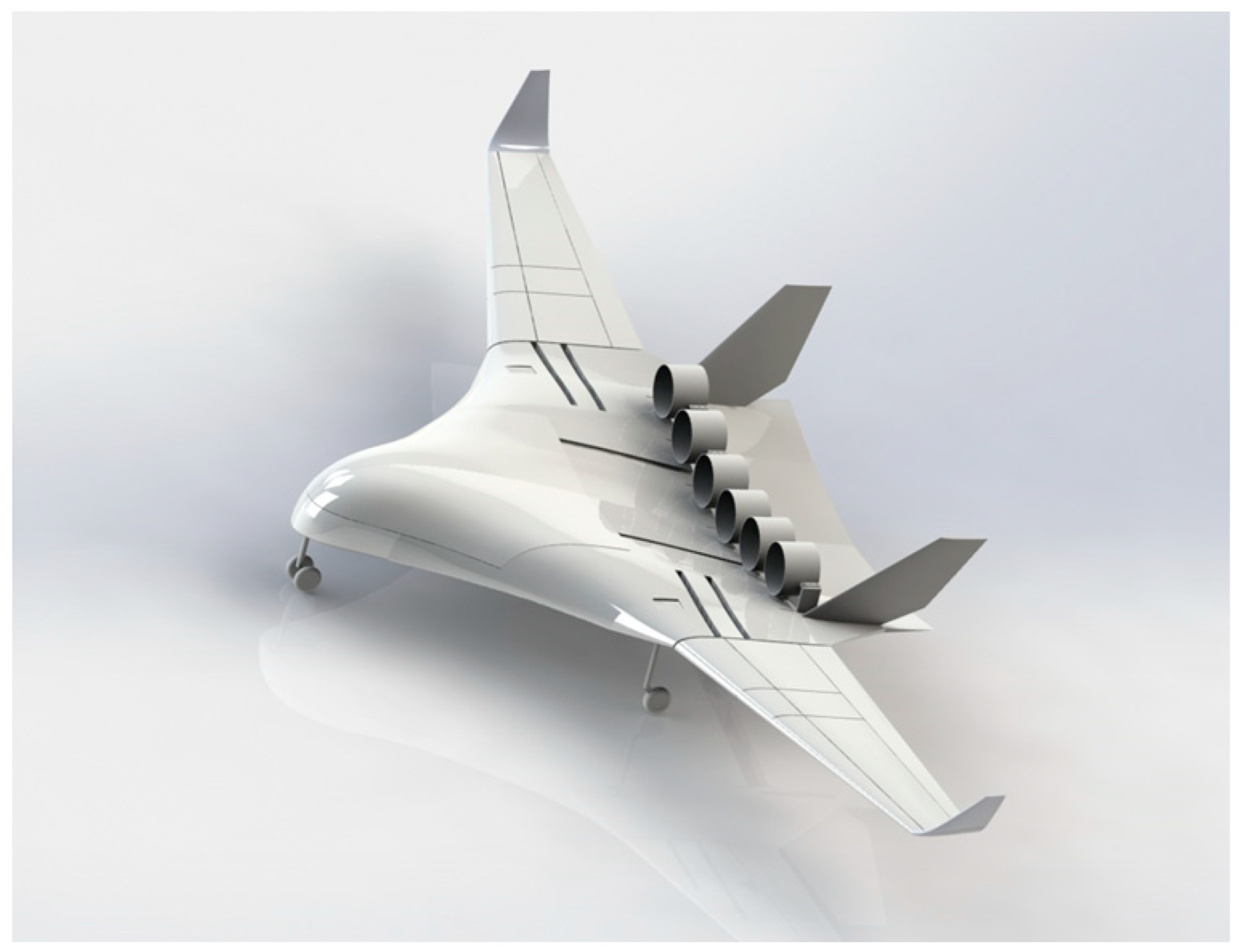
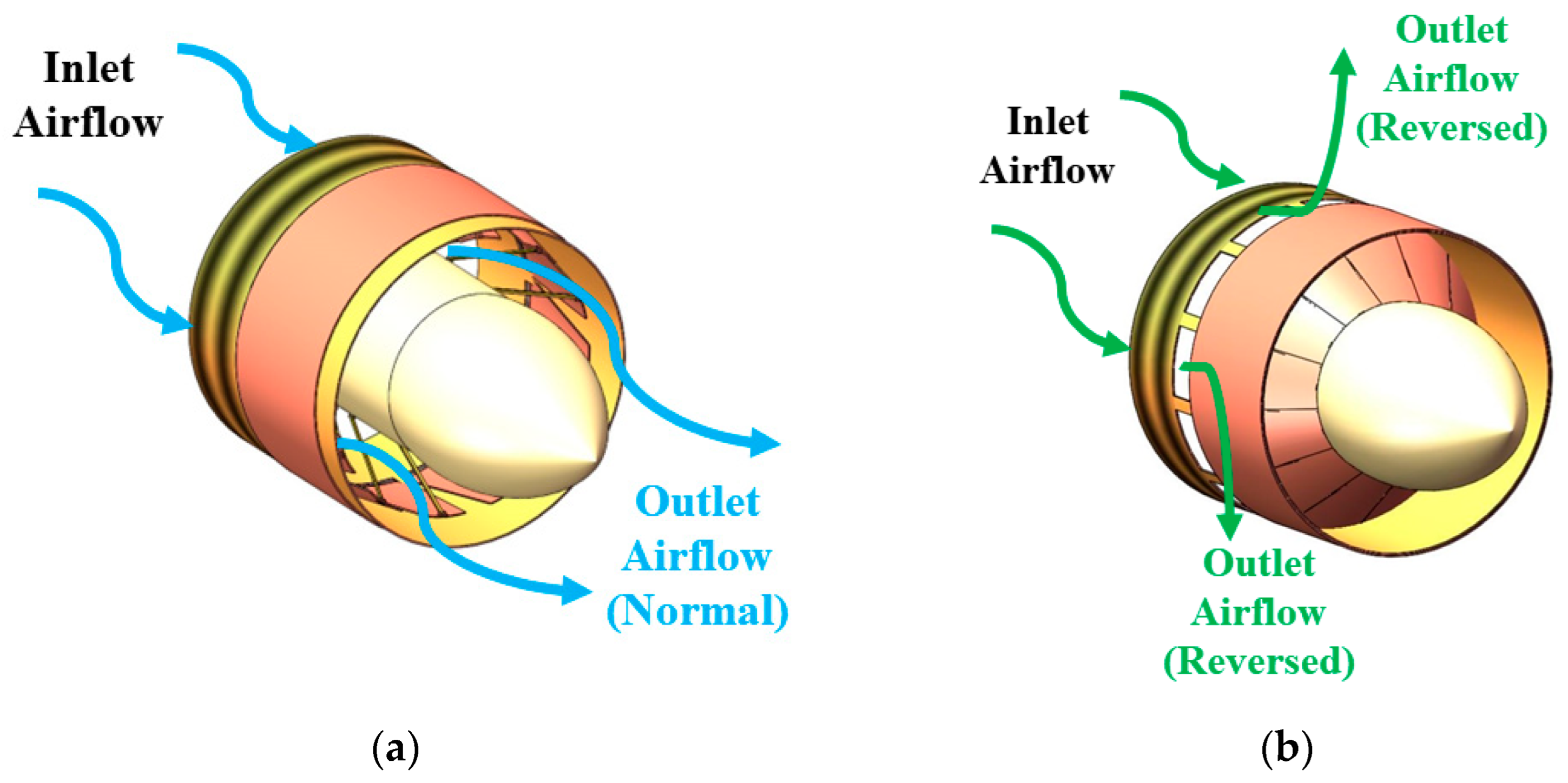
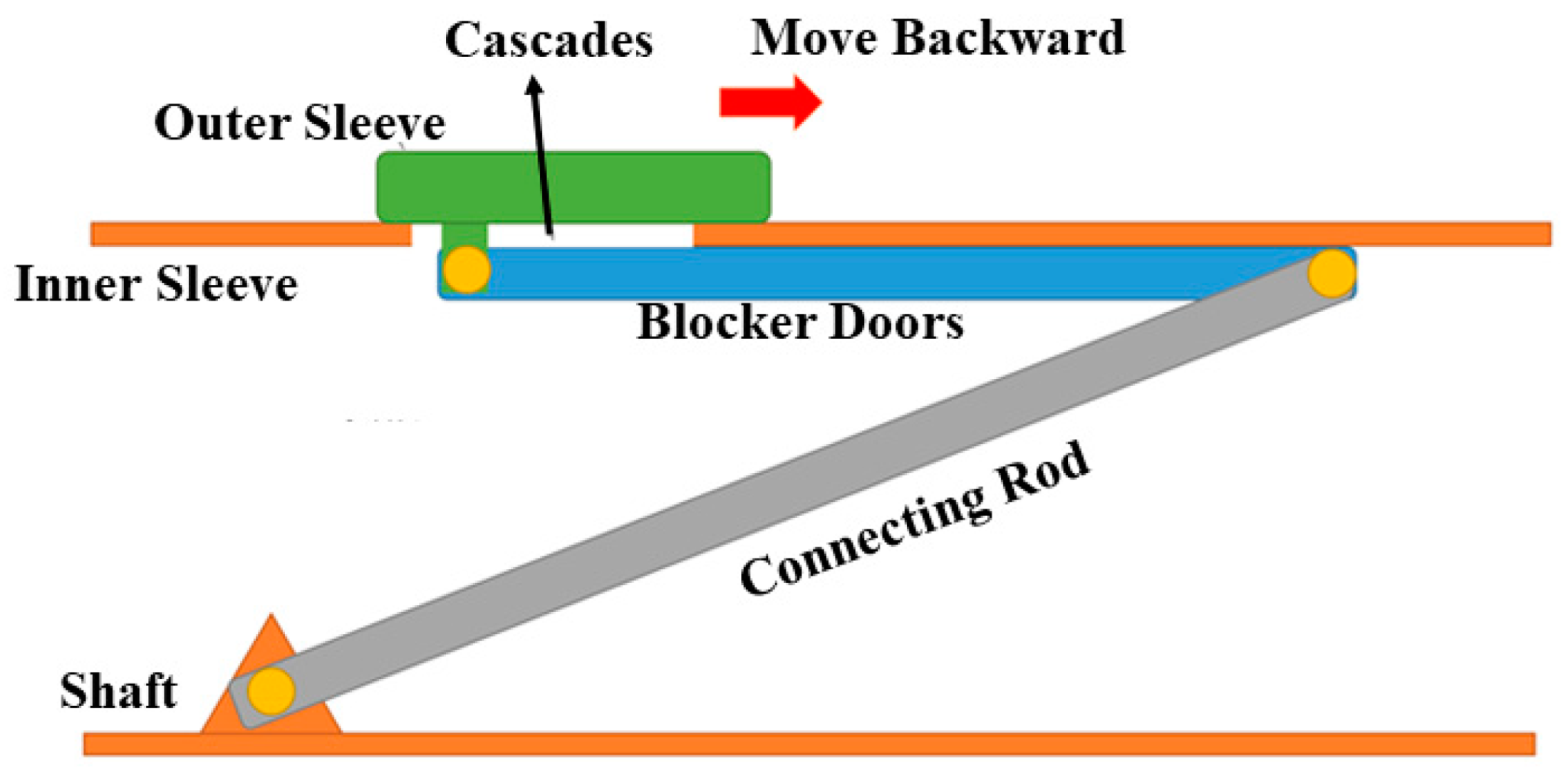

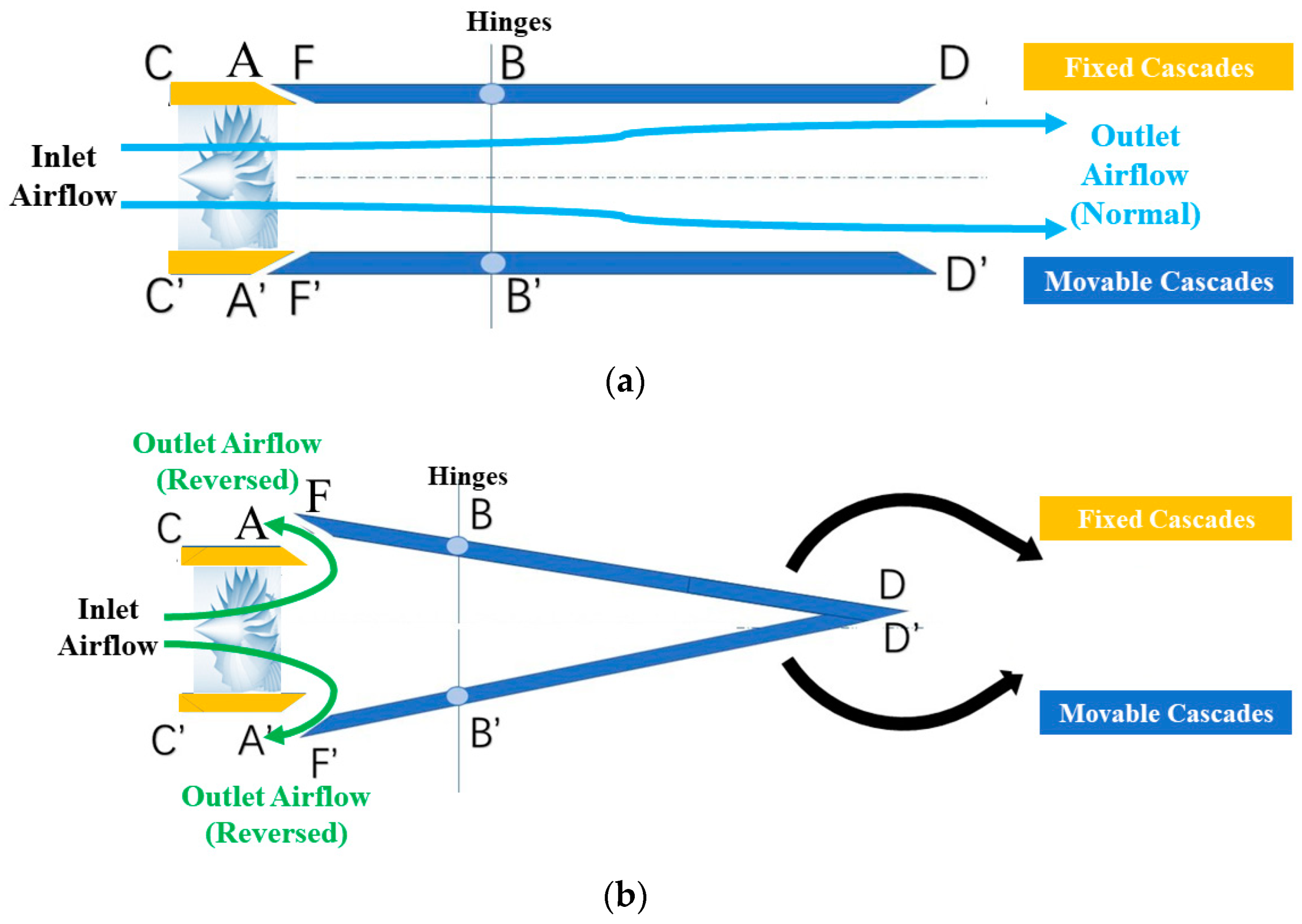
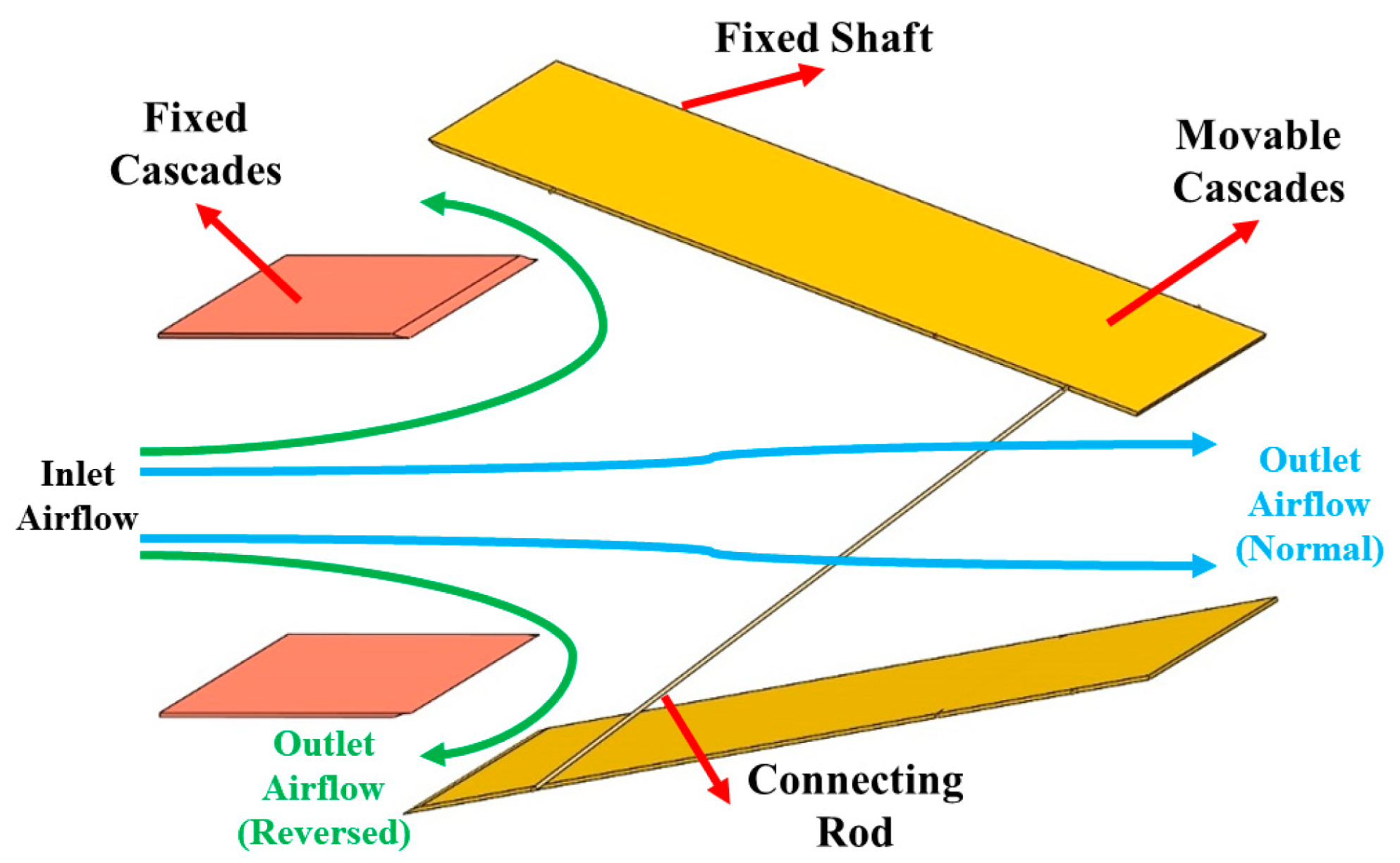


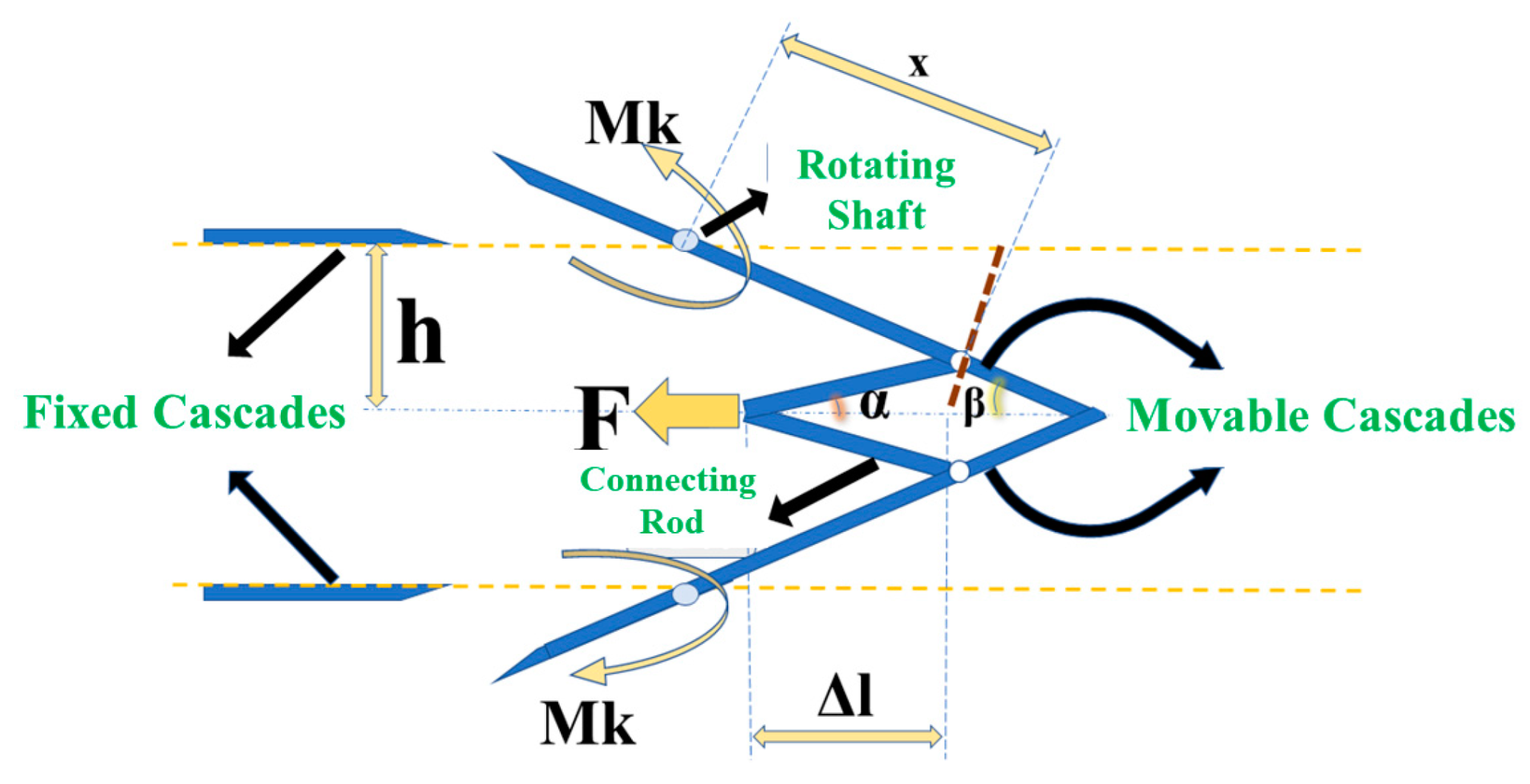
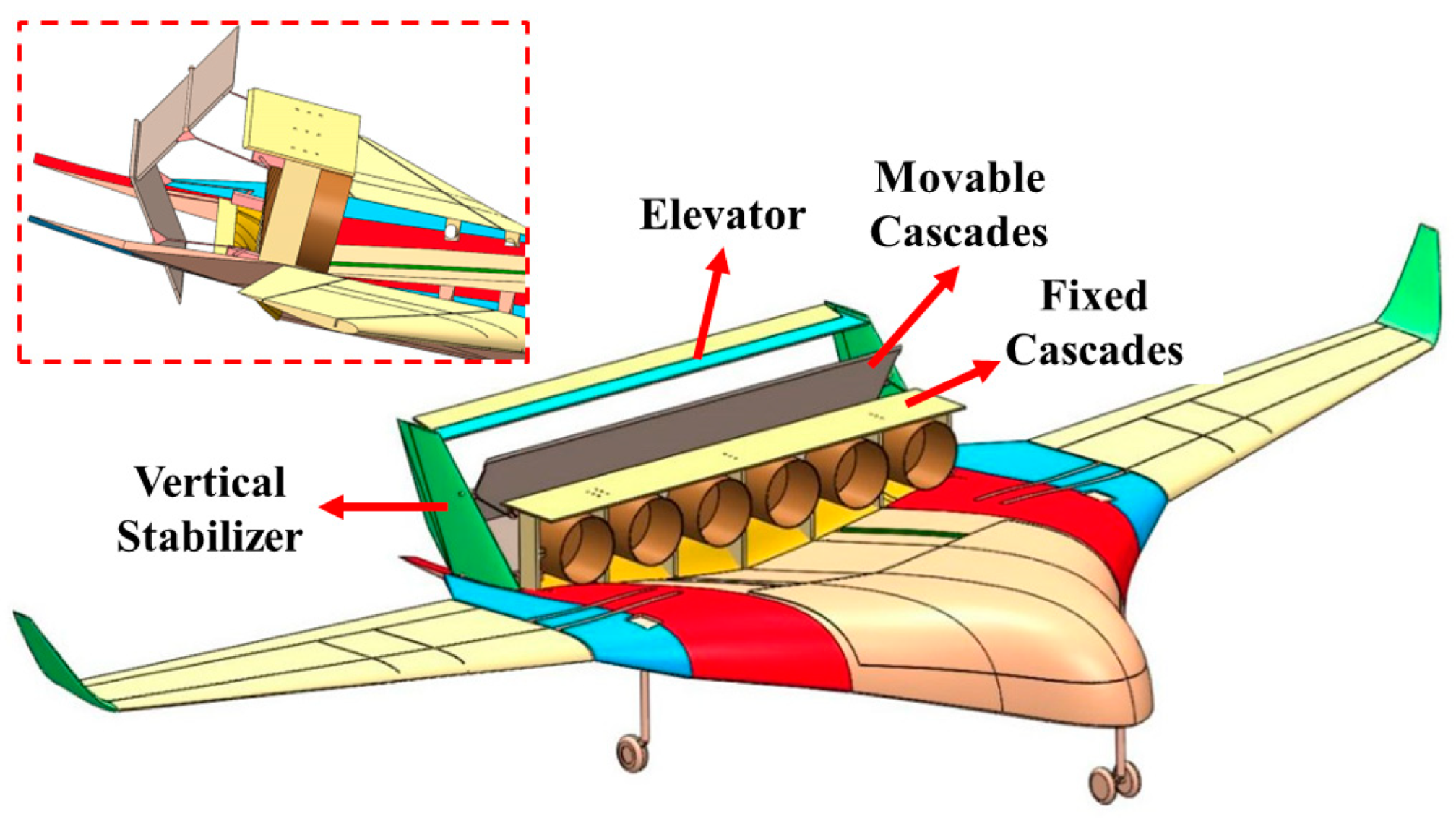


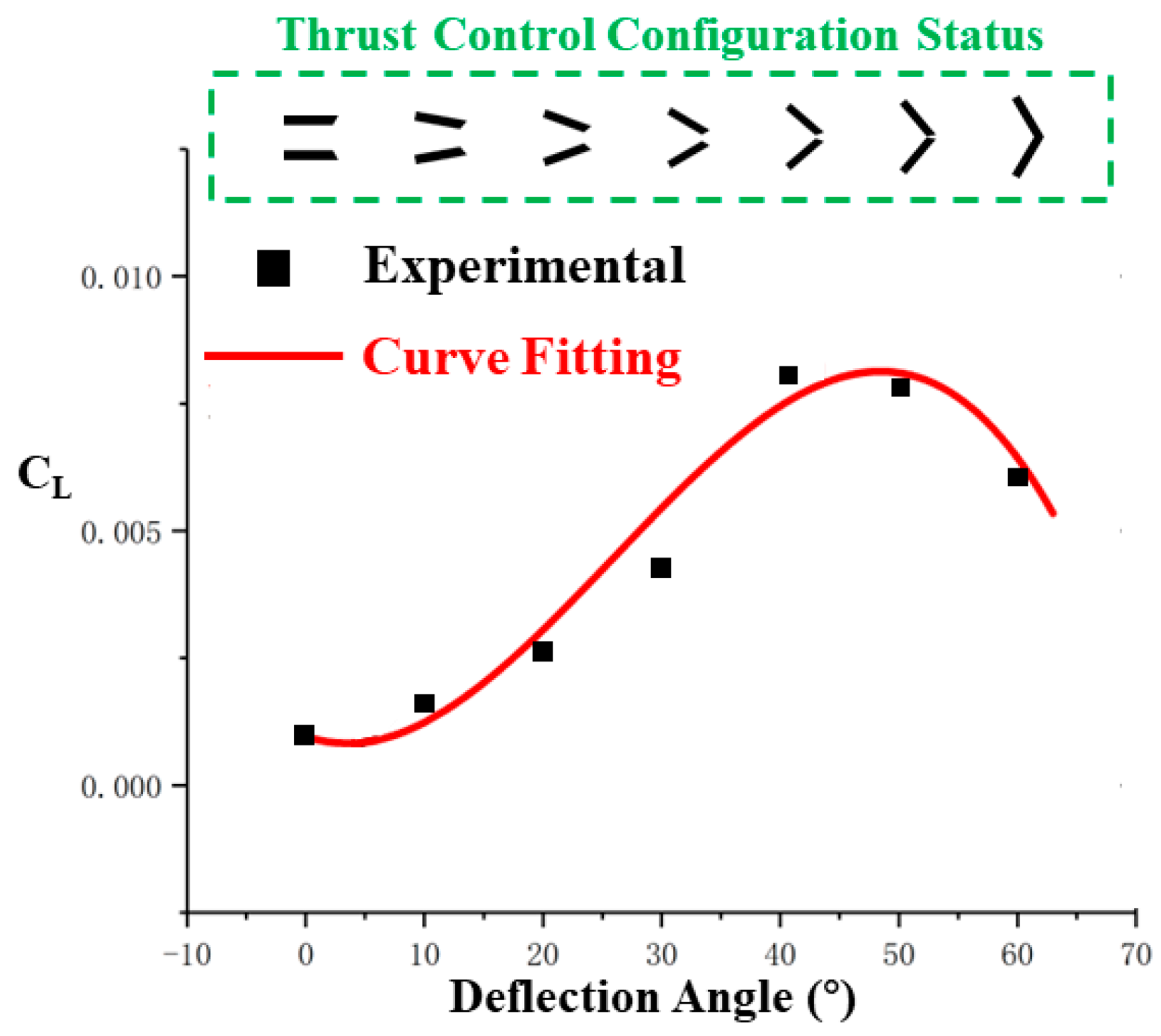

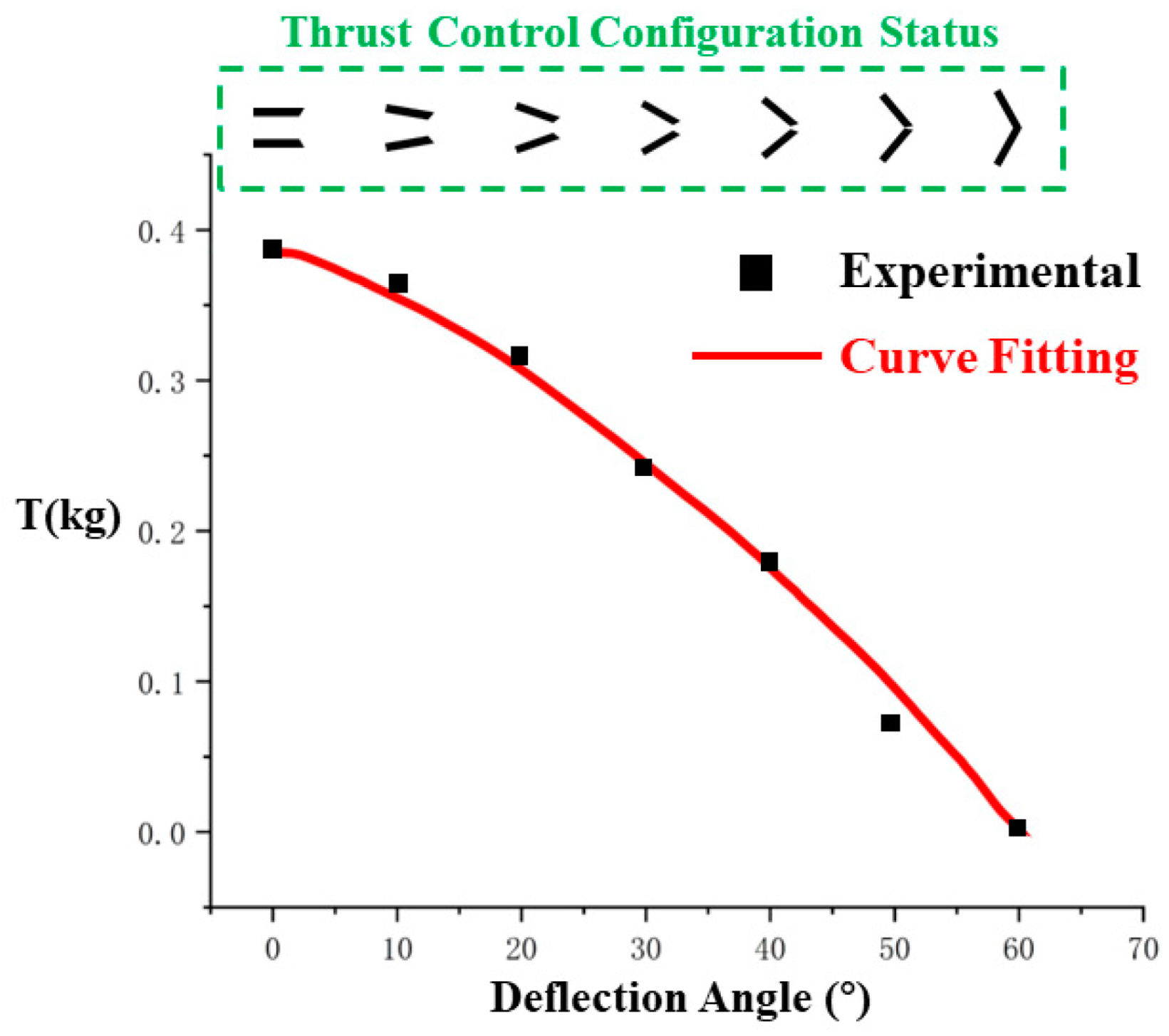
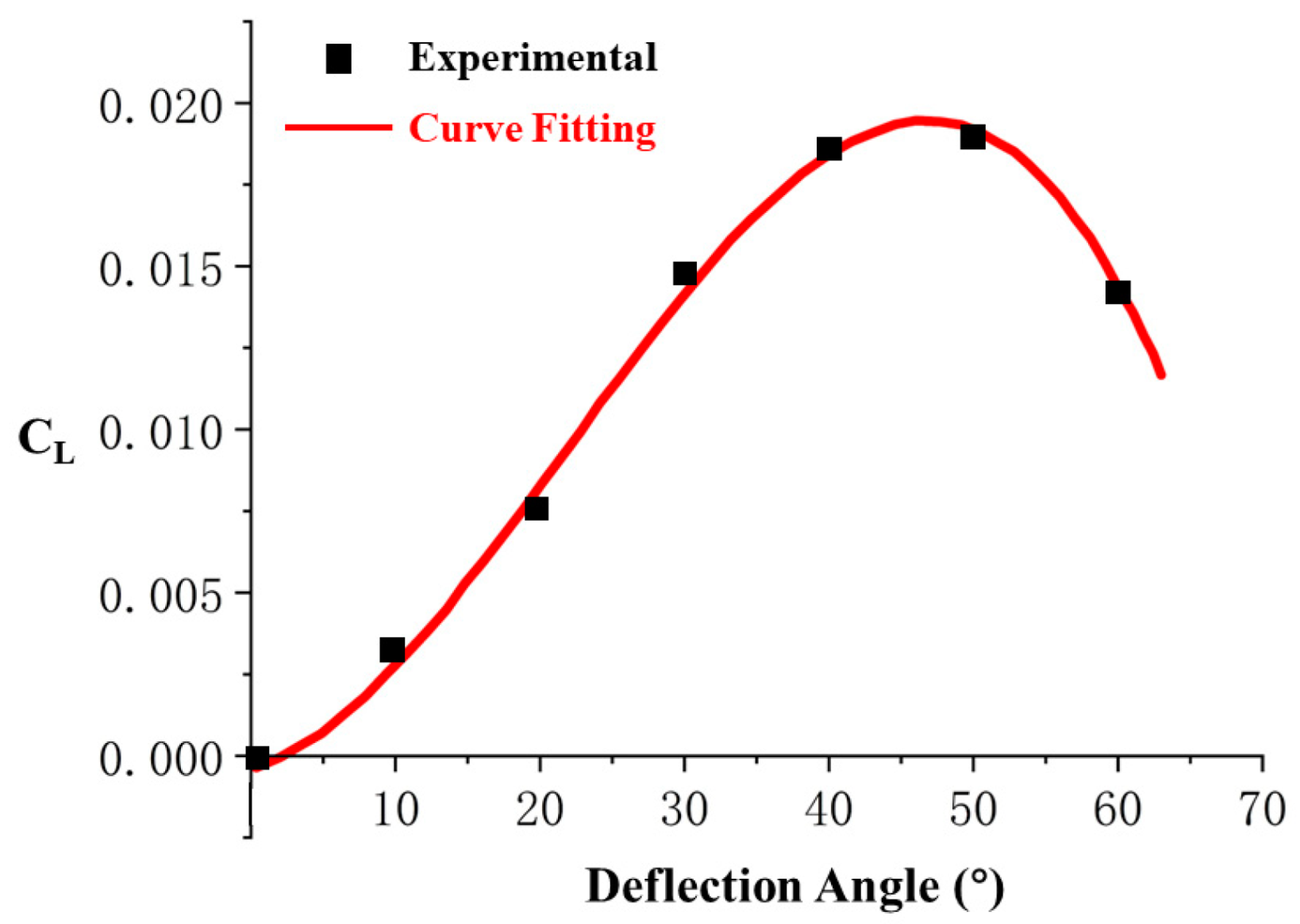
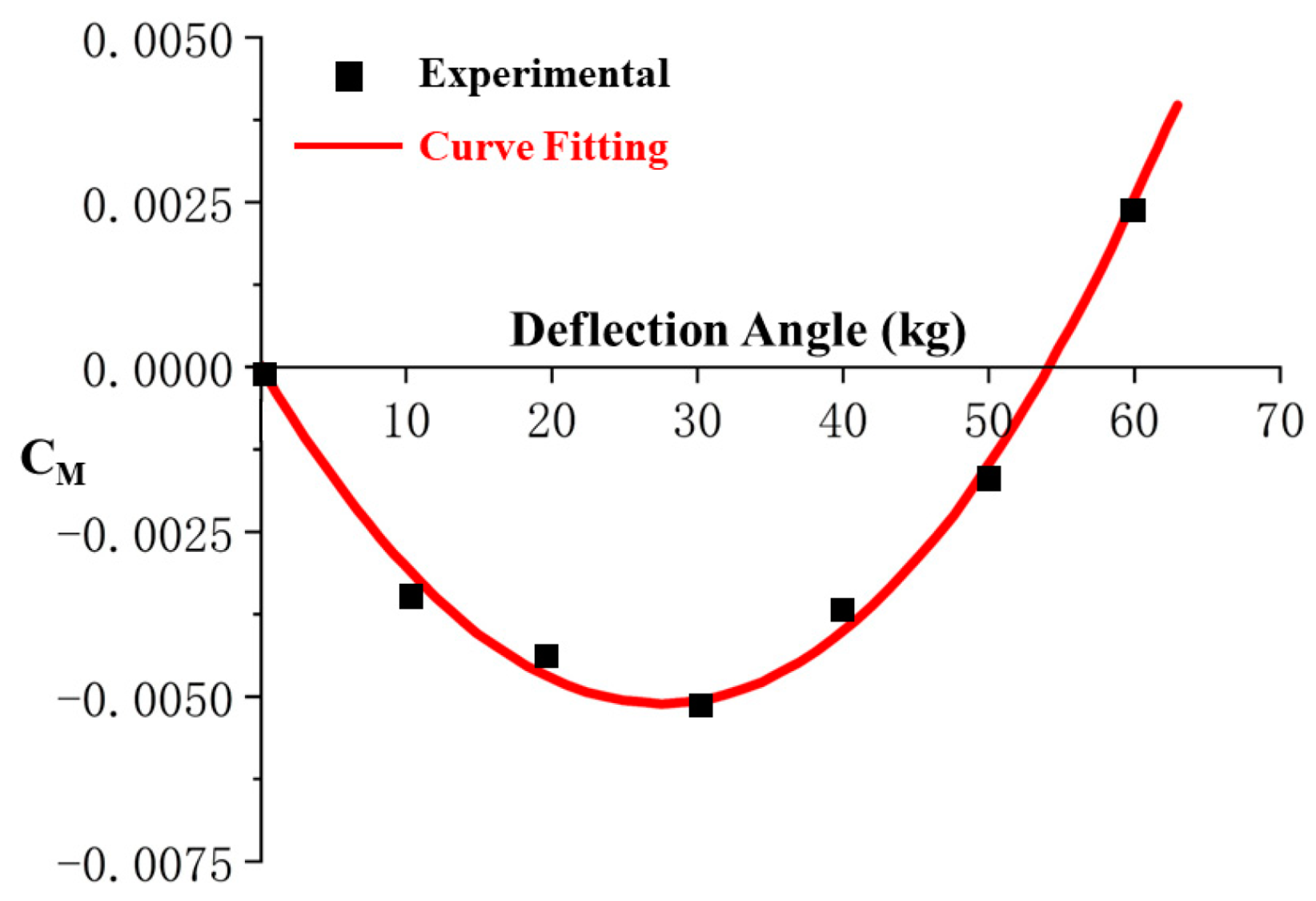





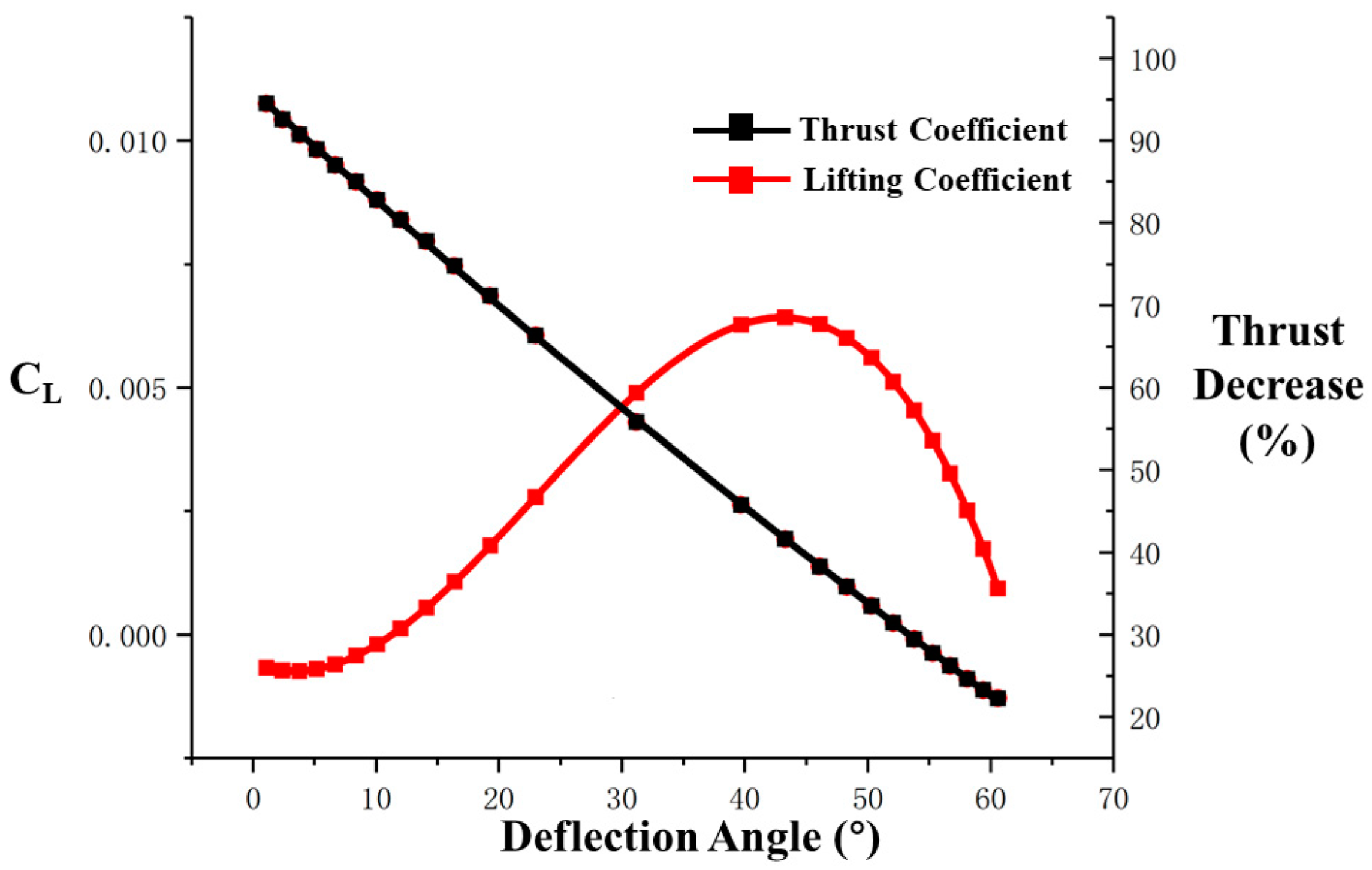
| To Maintain Lift and Reduce Speed During Landing | Traditional Tube-and-Wing Aircraft [53,54] | Aeroengine-Powered BWB Aircraft [51,55,56] | Electric BWB Aircraft with Novel Thrust Control Configuration |
|---|---|---|---|
| Methods | 1. Trailing-edge flaps used to increase lift. 2. Spoilers and engine thrust reversers used to slow down. | 1. Belly flaps used to increase lift. 2. Spoilers and engine thrust reversers used to slow down. | 1. Novel thrust control configuration behind BLI fans used to reduce speed and maintain lift without decreasing fan rotation speed. |
| Advantages | 1. Simple structure, easy to operate and maintain. 2. Mature design suitable for various applications. | 1. Greater lift augmentation due to central belly flaps. 2. Reduced interference with roll and pitch control, enhancing stability. | 1. Enhanced landing safety and controllability with thrust control configuration. 2. Without additional pitch moments. 3. Suitable for electric BWB without a fuel engine. |
| Disadvantages | 1. Difficult to use flaps and spoilers in BWB designs due to aerodynamic coupling between wings and fuselage. | 1. Belly flaps may cause flow separation. 2. Impossible to use engine thrust reversers in electric BWB aircraft. | 1. Complex structure increases the difficulty in design and maintenance. 2. Requires precise control to avoid instability. |
Disclaimer/Publisher’s Note: The statements, opinions and data contained in all publications are solely those of the individual author(s) and contributor(s) and not of MDPI and/or the editor(s). MDPI and/or the editor(s) disclaim responsibility for any injury to people or property resulting from any ideas, methods, instructions or products referred to in the content. |
© 2024 by the authors. Licensee MDPI, Basel, Switzerland. This article is an open access article distributed under the terms and conditions of the Creative Commons Attribution (CC BY) license (https://creativecommons.org/licenses/by/4.0/).
Share and Cite
Yu, M.; Tao, Z.; Li, H.; Tang, P. Optimizing the Landing Stability of Blended-Wing-Body Aircraft with Distributed Electric Boundary-Layer Ingestion Propulsors through a Novel Thrust Control Configuration. Appl. Sci. 2024, 14, 8546. https://doi.org/10.3390/app14188546
Yu M, Tao Z, Li H, Tang P. Optimizing the Landing Stability of Blended-Wing-Body Aircraft with Distributed Electric Boundary-Layer Ingestion Propulsors through a Novel Thrust Control Configuration. Applied Sciences. 2024; 14(18):8546. https://doi.org/10.3390/app14188546
Chicago/Turabian StyleYu, Mingxing, Zhi Tao, Haiwang Li, and Peng Tang. 2024. "Optimizing the Landing Stability of Blended-Wing-Body Aircraft with Distributed Electric Boundary-Layer Ingestion Propulsors through a Novel Thrust Control Configuration" Applied Sciences 14, no. 18: 8546. https://doi.org/10.3390/app14188546
APA StyleYu, M., Tao, Z., Li, H., & Tang, P. (2024). Optimizing the Landing Stability of Blended-Wing-Body Aircraft with Distributed Electric Boundary-Layer Ingestion Propulsors through a Novel Thrust Control Configuration. Applied Sciences, 14(18), 8546. https://doi.org/10.3390/app14188546





